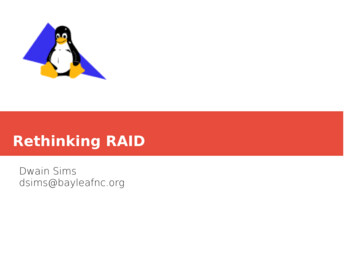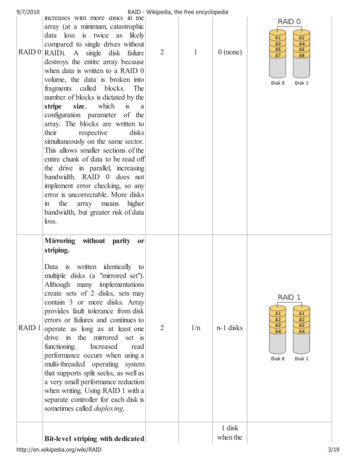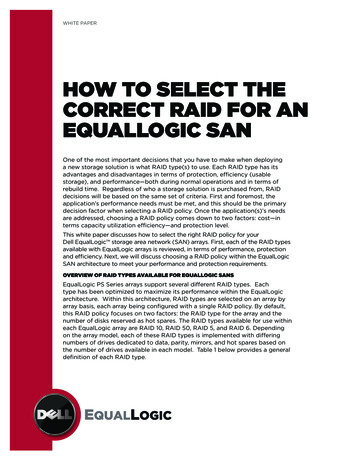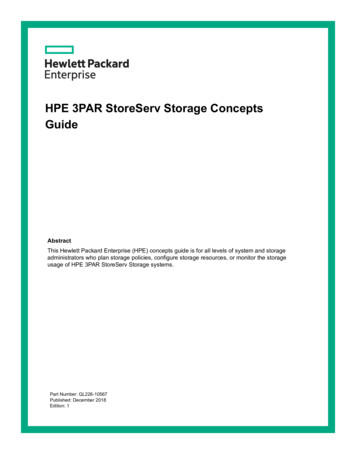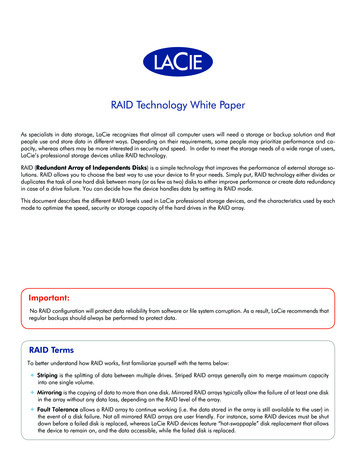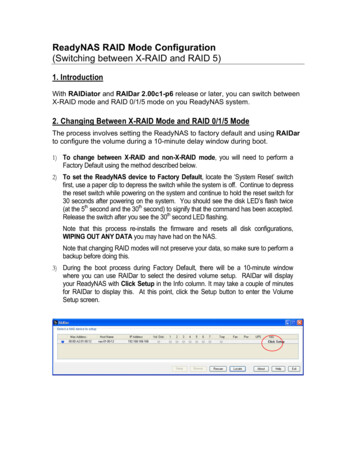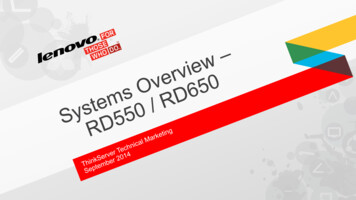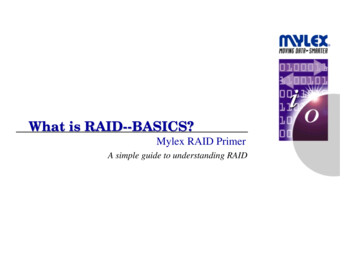
Transcription
What is RAID--BASICS?Mylex RAID PrimerA simple guide to understanding RAID
Let's look at a hard disk. PP260299.pptSeveral platters stacked on top of each other with a littlespace in between.One to n platters with a magnetic head on each side allconnected rigidly to one spindle. Hard disk drives store the programs and files with which you work. The most important program is the Operating System whichresides on the hard disk drive. Every computer ships with at least one hard disk drive2
A Single Drive - As RAID sees it A single physical drive or Multiple physical drives Used as a single system drive (one physical drive)Used as multiple system drives (more than one physicaldrive) attached through one or more SCSI or FibrechannelsThe RAID controller acts as an intelligent SCSI I/O port Benefits include ECC memory, battery backup and other faulttolerant features not available in non-intelligent SCSI I/O portcontrollersRAID stands for: PP260299.pptJBOD (Just A Bunch Of Disks)Redundant Array of Inexpensive/Independent Disks3
Single Disk (No RAID)Data StripesDisk DriveeXtremeRAID 1100Example: Data is written to one disk as it is read from system memory.PP260299.pptDisk Drive4
RAID Levels RAID 0 RAID 1 Striping with Parity. Data is striped across multiple disksand parity is written to one additional disk.RAID 5 PP260299.pptMirroring. Data is written identically to a multiple of twodisks simultaneously.RAID 3 Striping. Data is striped across multiple disks.Data and parity are written across multiple diskssimultaneously.5
RAID Applications PP260299.pptTransfer Rate Intensive Applications: (Typically RAID 0 environments)RAID striping is ideal for transfer rate-intensive environmentsA transfer rate-intensive environment consists of : Applications that require a large amount of data to be processed ina fixed amount of time Video playback and video editing are typical transfer rateintensive environments Photo processing, manipulation and renderingRequest Rate Intensive Applications: (Typically RAID 5 environments)RAID is used in highly multi-tasking, request rate-intensiveenvironmentsA request rate-intensive environment consists of: databases, file/web servers: -- high number of random smallerrequests.A RAID drive can be configured to process each request within astripe, allowing multiple requests to be processed in parallel.6
RAID 0 - StripingRAID 0 uses disk striping.Multiple hard disks used to form a logical drive.Hard disks are striped using the stripe size specified during configuration.A request less than the stripe size is sent to one hard disk. A requestgreater than the stripe size is divided into multiple requests and sent tomultiple disks, in parallel.Typically used in data rate intensive applications (video editing)three-drive RAID with a predefined stripe size of 32K. A 72K request Example: Consider a three-drive RAID with a predefined stripe size of 32K. A 72K request would be broken up into three chunks of32K, 32K, and 8K, with the first 32K going to one drive, the next 32K going to the next drive, and the last 8K going to thethird drive. Each of these requests would be sent in parallel to the three drives to be serviced simultaneously.PP260299.ppt7
RAID Level 0 - Disk StripingData StripesDisk DriveeXtremeRAID 1100Example: Data split in equal chunks and is written to multiple disks in parallel. The data transfer rate is the aggregate sum of all the drivesavailable in the array minus any overhead.PP260299.ppt8
RAID 1 - Mirroring RAID 1 provides the highest level of faulttolerance to a single drive duplicates each I/O request to a secondarymirror hard drive. RAID 1 requires a multiple of two drives -the primary set and the mirror set. Mirroring is suited for any applicationwhere protection from drive failure isrequired.Mirroring allows two drives to mirror on the same channel or "duplex" acrosstwo channels/two host adapters. The mirror drive must be equal or greater in capacity than the primary driveIn case of a drive failure, all I/O requests are re-directed only to the remaining gooddriveUsed to store only the important data from applicationsAlso used to protect the main drive where applications are installedProvides immediate disaster recovery when a drive fails.PP260299.ppt9
RAID Level 1 - Disk MirroringData StripesDisk DriveeXtremeRAID 1100Example: Data is copied and written to an identical drive in parallel. This provides a redundantconfiguration for disaster recovery.PP260299.ppt10
RAID 3 and RAID 5 RAID 3 and 5 stripes data across multiple drives and adds parity for fault tolerance.RAID 3 writes all parity information to one single drive.Mylex RAID 5 controllers implement “rotational parity” for increased drive reliabilityand reduced “single point of failure”.RAID 5 is the predominant highly available, fault tolerant RAID level used in serverstoday.RAID 5 applications include OLTP (online transaction processing), file server and webserver applications requiring 24/7 up-time.RAID 5 ArrayExample: Consider a three-drive RAID 5 set. Each block or “stripe” of data is split across as many drives (n-1) as will fit. The remaining drive containsthe parity information to re-construct the previously written striped data in case of a failure. The parity block is rotated amongst all the drives so that onesingle drive does not get accessed more than any other drive.PP260299.ppt11
RAID 5 Disk Striping w/ rotational ParityData StripesParity StripeseXtremeRAID 1100Disk DriveExample: Data is split in equal chunks and is written to multiple disks in parallel. The remaining drive contains the parity information to reconstruct the previously written striped data in case of a failure. The parity block is rotated amongst all the drives so that one single drivedoes not get accessed more than any other drive.PP260299.ppt12
RAID 00, 10, 30, 50Provides Multi-layer RAID configurationsIdeal for TPCC configurationsMultiple RAID Level 0, 1, 3, or 5 Arrays can be “striped” together tocreate RAID Levels 00, 10, 30, or 50 Provides more capacityOften referred to as ‘Spanning’Provides better I/O load balancing RAID 50RAID 5RAID 5RAID 5Example: Three RAID 5 arrays are “striped “ together for added capacity and as a means to add additional drives to a large array.PP260299.ppt13
RAID Controllers Low Cost RAID for Desktops and Entry-level Servers High Performance RAID for Mid-level to High-end Servers Up to 3 channel PCI-to-Ultra SCSI & PCI-to-Ultra2 SCSI RAID; up to128MB cache; ECC (some models)examples: Mylex eXtremeRAID SeriesExternal RAID for enterprise level servers PP260299.ppt0 or 1 channel PCI-to-Ultra2 SCSI RAIDexamples: Mylex AcceleRAID Series2 channel Fibre to 4 Ultra2 SCSI RAID; 256MB mirrored cacheexamples: Mylex DAC-FL Series14
RAID Advantages! RAID provides an environment of highly reliable, fault tolerant diskdrive sub-systems RAID adds life to disk drives as the controller manages the I/O loadequally amongst all the drives in the Array reducing the risk of “singlepoint-of-failure” A “successful” RAID environment includes reliable robust disk drives Each RAID environment will include multiple disk drives Mylex PCI RAID controllers can attach as many as 45 drives per RAIDcontroller, up to 16 controllers per system for an astonishing -- 720 diskdrives per system configuration Mylex external RAID controllers can attach as many as 90 drives perstorage subsystem and can reside as part of a SAN (Storage AreaNetwork) Capacities range from terabytes to petabytes!PP260299.ppt15
Where can I use RAID? LANs/WANs Enterprise Servers SANs Clustering environmentsPerformance DesktopSystems Mission critical installations PC Workstations News centers Workgroup/File Servers Internet News Servers E-Mail Servers Intranet/Web Servers Application ServersPP260299.ppt16
MYLEX RAID Broadest line of RAID controllers in the world Low Cost RAID for Desktops and Entry-level ServersHigh Performance RAID for Mid-level to High-end ServersExternal RAID for Enterprise-class ServersStrategic relationships with industry leaders Intel, Microsoft, System vendors, Drive vendors & Software suppliers Mylex has the world’s fastest RAID Controller Partner with 7 of the top 10 server OEMs Leading RAID supplier in the channel Over 1,000,000 Mylex RAID controllers in the field Mylex rated #1 in non-captive market share by IDC, DataQuest &Disktrend ---- 1998 Mylex is synonymous with RAIDPP260299.ppt17
Mylex RAID for All Server Solutions AcceleRAID Series: Cost Effective PCI RAID Solutions for: eXtremeRAID Series: High Performance PCI RAID Solutionsfor: Mid-level ServersHigh-end ServersDAC Series: External RAID Solutions for: PP260299.pptEntry-level Servers“Win/tel”-based WorkstationsHigh-end Desktop SystemsEnterprise-class ServersClustering and High Data Availability ApplicationsStorage Area Networks18
AcceleRAID TechnologyRISC -i960Ultra2 SCSILow CostPP260299.ppt 0 or 1 Ultra2 SCSI Channels Up to 4MB Flash EEPROM Up to 128MB MB EDO RAM w/ECC Up to 1 int. 1 ext. SCSI connectors PCI 2.1 compliance PCI Hot Plug RAID 0, 1, 0 1, 3, 5, 10, 30, 50, JBOD Also used in Systems with a PCI slotdedicated for add-in RAID controllers,providing 1 SCSI channel in additionto the number of channels on theMotherboard (AcceleRAID 250)19
eXtremeRAID Technology233 MHz SA 110,Ultra2 SCSI,64-bit PCI 2 or 3 Ultra2 SCSI Channels Up to 4MB Flash EEPROM 32 or 64 MB parity SDRAM BBU module Up to 3 internal and 3 externalSCSI connectors PCI 2.1 compliance Dual Address Cycle PP260299.pptPCI Hot Plug 6000 Random I/O’s 75 MB/second sustained datatransfer rate20
DAC-FL: TechnologyTwo RISC Processors,2Fibre Channel loops,Ultra2 SCSIPP260299.ppt Up to 256 MB Data Cache Dual PCI Bus design 5 1/4” form factor 2 Copper FC-AL host channels Burst cache transfer rates: Upto 97 MB/s per host channel 4 Ultra2 SCSI LVD channels 15 devices per Ultra2 SCSIchannel - 60 devices/controller Up to 1.08TB per controller Sustained disk transfer rates:over 52MB/s21
DAC-FF: TechnologyTwo RISC Processors,2Fibre Channel to host,4Fibre Channels to drivesPP260299.ppt Up to 256 MB Data Cache Dual PCI Bus design 5 1/4” form factor 2 Copper FC-AL host channels Burst cache transfer rates: Upto 189 MB/s 4 Fibre channels to drives 125 devices per Fibre channel 500 devices/controller Up to 9.0TB per controller22
RAID 0 - Striping RAID 0 uses disk striping. Multiple hard disks used to form a logical drive. Hard disks are striped using the stripe size specified during configuration. A request less than the stripe size is sent to one hard disk. A request greater than the stripe size is divided into multiple requests and sent to multiple disks, in parallel.

